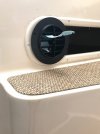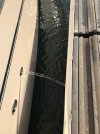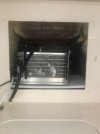It works!
Went down to boat yesterday to make some of the temporary pieces more permanent. I.e., cut more holes in the boat. But they had a slip open with power. So in she went. And to my pleasant surprise, all seemed to work.
When I first opened the seacock, water rushed through the lines pretty quickly. I was glad I used fairly clear lines. Only a couple of very small air bubbles came in and they zipped right through my strainer, pump and bleed-off valve. I only have two outlet vents and there was good air flow at each. It was a cool morning, but the air felt cold.
View attachment 24167
Then I went outside to check on water flow. It looked to me like the 500 GPM pump was flowing great.
View attachment 24168
Truth be told, I ran into one hiccup - of my own making, of course. At first, the unit came on, but with no fan. So I called Mermaid (who have been great throughout this install). Tom instructed me to removed the face plate of the thermostat (which came off too easily, big hint), and use needle nose pliers to touch red and black. Fan came on. "You don't have your thermostat face plate pins lined up with the receivers on the back of the thermostat", said Tom.
Well, that's because the instructions called for drilling a hole behind the face plate for the wires to come into the face plate. I didn't want to have a hole there, so I brought the wires in through the side of the face plate. After bringing the wires in from the back of the thermostat and making sure the face plate snapped in place solidly, everything seemed to work as it should.
The unit was noisier than I had hoped, but I also had no cover over it at all. I wanted to be able to see all the water line connections. I do regret not placing some thick rubber padding beneath the unit. It would be a bear to do that now. I will wait until I use the plexiglass as a template to make an air intake cutout in the original PVC panel and get it in place and then see how much that cuts the sound down. If still noisy, then I'll consider the rubber pad.
Also, Mermaid says there should be two or three 4" outlet vents. I'm going to start with 2. After running the air through 9' of 4" ducting, I'm not sure I see the advantage of adding more vents. Perhaps if I could spread them around the cabin, that would help, but I can't. At least not without running exposed venting through the head. That wouldn't look too professional.
In any case, I'm glad it works. I've got some more work to do, like make the thermostat right and install the vent in the photo.. Then I won't know until about August just how well it works!
Rob




